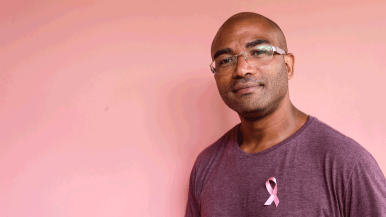Although breast cancer in men is rare — less than 1% of all breast cancer cases develop in men — about 2,700 new cases of breast cancer will be diagnosed this year, according to the American Cancer Society, And the numbers have been rising.
Like women, men are born with breasts — although they don’t produce milk — and their breast cells and tissue can develop cancer, too.
“Breast cancer is not just a women’s condition,” says Ruta Rao, MD, a medical oncologist and breast cancer specialist at RUSH MD Anderson Cancer Center. “The disease may be rare in men, but it doesn’t mean it can’t happen. Men need to be aware of the signs, too.”
Rao shares facts about breast cancer in men — including the symptoms, risk factors and treatment options.
Early detection is key
Although there are no screening guidelines for men, they still have a breast cancer lifetime risk of 1 in 833, according to the Cancer Society. Rao emphasizes the importance of men working self-exams into their daily routine.
“Men should be mindful of any changes to their body, including in their breasts, and bring it to the attention of their doctor if they notice something unusual,” she says. “Depending on when it’s caught, the cure rate for men is high, so it’s important to remember that early detection is key.”
The signs and symptoms of breast cancer in men can include the following:
- A lump or swelling, which is often (but not always) painless
- Nipple retraction (turning inward)
- Redness or scaling of the nipple or breast skin
- Discharge from the nipple
- Skin changes, such as redness or swelling
If you notice any breast changes, Rao recommends connecting with your primary care provider for more guidance.
The risk factors
Several factors can increase a man’s chance of getting breast cancer. But having risk factors does not mean you will get breast cancer.
Following are some key risk factors:
Family history and gene mutations: If a man tests positive for genetic mutations associated with breast cancer — either the BRCA1 or BRCA2 gene — he has a higher risk of developing breast cancer, and his children have a 50% chance of carrying the genetic mutation as well. Find out if you have the BRCA genes via genetic testing.
Obesity and hormone imbalances: Studies have shown that obesity plays a role in breast cancer risk for women and men. The reason is that fat cells in the body convert male hormones, or androgens, into female hormones, or estrogens. This means that obese men have higher levels of estrogens in their body, which can contribute to a risk of breast cancer.
Priority populations: Black men have a slightly higher risk of developing and dying from breast cancer. In fact, a study found that when receiving similar treatment, Black men ages 18 to 64 were 76% more likely to die from breast cancer than white men. And overall, Black men with breast cancer have a worse prognosis than white men.
Age: As with women, the incidence of breast cancer in men increases with age. Men also tend to be approximately five to 10 years older than women at the time of diagnosis.
Treatment options
Treating male breast cancer is similar to women’s breast cancer, and the type of breast cancer that men and women are diagnosed with determines the course of treatment. To determine the type and stage of the breast cancer, men may go through a variety of testing, such as mammograms, ultrasounds, MRIs and biopsies.
Once your care team determines the type of breast cancer, Rao says they will work with you to create a care plan that is best for you.
Following are other treatments for men with breast cancer:
- Chemotherapy
- Radiation therapy
- HER2 medication
- Targeted therapy
- Immunotherapy
- Hormone therapy
- Surgery
“For men with breast cancer, the most common treatment we see is a mastectomy (or removal of the breasts),” Rao says. “The procedure is similar to that of women but the difference for men is that they have very little breast tissue, so it’s the most effective way to remove the tumor and reduce the potential for a reoccurrence.”
More awareness is needed
One of the challenges of breast cancer in men is the lack of awareness and education. Because it is somewhat rare, most people do not know that men can develop breast cancer.
And when receiving a breast cancer diagnosis, Rao notes that men shouldn’t feel embarrassed and emphasizes the need to continue to educate others to help decrease the stigma.
“Men (and our society) need to know that breast cancer in men does exist, and that help is available,” she says. “It may be uncommon, but if caught early enough, we can intervene and help save your life.”




